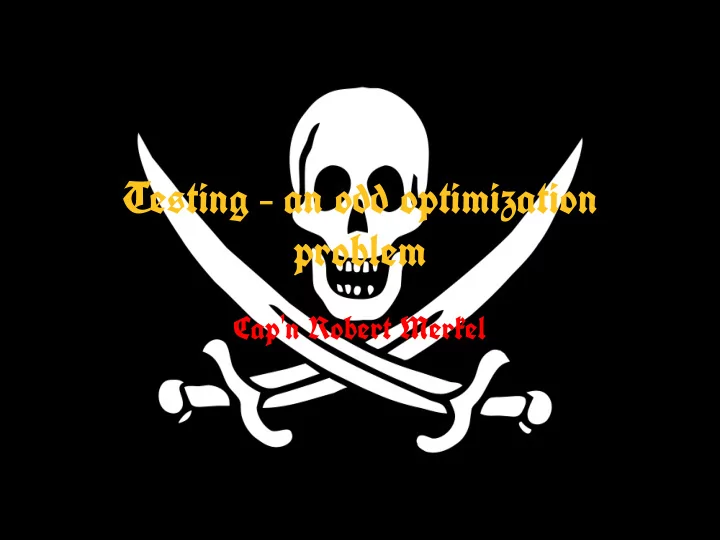

Testing – an odd optimization problem Cap'n Robert Merkel
A-ha Me Hearties???? Why pirates??? Because we're going to go searching for buried treasure!
The search • A chest of buried treasure somewhere on the island • No X on the map…
The rules • One treasure chest • Known size, shape, and orientation • No information about location – equally likely to be anywhere on the island • Only way to search – dig a hole. • Minimize expected # of holes required. – The F-measure (because each failed attempt equals a flogging by the captain).
Plan #1 • Cap'n Rrrrt 1. Choose a spot randomly. 2. Dig there. 3. If treasure found, stop, 4. otherwise, back to step 1
Plan #2 • Captain Aaaaaart 1. Choose n possible candidate places to dig. 2. Choose the candidate c with the greatest distance from the nearest existing hole (maximin criterion) 3. Dig at location c 4. If treasure found, stop 5. Otherwise, back to step 1.
Results • Plan B - ~40% fewer holes than plan A. • But what about Plan C, D, E… • Tried many. • Supplies of rum ran tragically low. • Some of them were lower-overhead than plan B. • Results were roughly the same.
Why???? • Were we too busy drinking rum and chasing wenches? • A more fundamental problem?
Mathematics to the rescue
An Optimal Strategy
An Optimal Strategy X X X X X X X X X X X X X X X X X X X X X X X X X X X X X X X X X X X X X X X X X X X X X X X X X X X X X X X X X X X X
An Optimal Strategy X X X X X X X X X X X X X X X X X X X X X X X X X X X X X X X X X X X X X X X X X X X X X X X X X X X X X X X X X X X X
Random vs. Optimal • Random F-measure – area of treasure is a – area of island is A – F-measure for random is A/a • Optimal (and yes it is optimal) – A/a test cases – On average, hit treasure half way through – F-measure is A/2a • Captain Aaaart's strategy not far off optimal!
In case it's not obvious • Island == input domain of software • treasure chest = "failure region" • Result still holds if multiple failure regions, n dimensions etc. • Also holds if input domain modeled as discrete rather than continuous.
Upshot… • If we're going to improve testing we need to change assumptions!
What is the ultimate goal anyway? • Not digging for buried treasure! • Multiple faults within input domain. • Lead to multiple failure regions. • Ultimate goal (Littlewood et al) – improve reliability as much as possible after faults detected in testing are fixed. • Fiendishly hard to model
Improving failure detection • Incorporate guess where failures are most likely. • Add some clues to the treasure map…
Failure-proportional sampling • Discrete (and large)input domain, k inputs i_1, i_2,… i_k • Prior probabilities for failure p_1, p_2… p_k • Select randomly with replacement. • Assign selection probability s_i = failure probability p_i • Sounds like a good idea, right?
Optimal strategy • Turns out to be no improvement on uniform random selection. • Optimum strategy = s_i = sqrt(p_i) • Strategy came from Press(2009). Paper was about looking for terrorists.
Combining locality and probability • Locality on its own -> 50% improvement • Probability on its own -> not so useful either – Leads to repeatedly hitting high-probability areas. • Need to combine them. • Essentially, trying to have a formal mathematical model of debug testing • But…modelling this is *really* hard.
The brute force model i1 i2 i3 P F F F P1 F F T P2 F T F P3 F T T P4 T F F P5 T F T P6 T T F P7 T T T P8
The brute force model • Represents our prior beliefs about failure behaviour • Can calculate our current beliefs about program reliability. • In practice, table is intractably huge (2^input domain, where input domain is already huge) • Not obvious what we’d do w/information to deliver reliability improvements. • Despite size, doesn’t represent everything we’d like to model
Mistakes, failures and faults • Mistakes (brain fart) -> fault (code fart) -> failure (output fart) • To improve delivered reliability, fix the faults which cause the most failures. • Need to incorporate in the model? – But model is already intractable!
So…I’m kinda lost
Recommend
More recommend